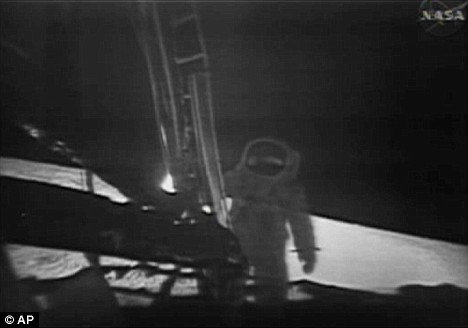
Do you remember that dreadful moment when you randomly grabbed a VHS tape to record a basketball game on your VCR, only to discover that you had just taped over the one and only copy of your daughter’s dance recital?
Wait until you hear what NASA did.
The story begins with Neil Armstrong’s historic first step onto the surface of the moon on July 20, 1969.
NASA had built a special camera that was affixed to the side of the Lunar Module. It is still there right now on the moon. The camera worked perfectly. Pristine footage of Armstrong’s descent down the ladder was relayed back to earth.
The rest of humanity, of course, hoped to share in this epochal moment via live television. But the space camera recorded in an odd format, one that couldn’t be converted directly into TV signals. As a result, the images were degraded.
If you got to experience that historic moment in your own family room, you might remember squinting at the TV screen. “I guess that’s Armstrong’s foot…OK, it looks like he’s moving…”
The images were blurry at best. The excitement, of course, trumped any real disappointment. Besides, NASA still has those beautiful original tapes.
At least they thought they did.
Do you recall that spacious warehouse at the end of Raiders of the Lost Ark? There really is such a place. It’s called the Washington National Records Center. The archival footage of the Apollo 11 flight was presumably stored there in a box.
In the early 1980s, however, America put a number of new satellites into orbit. They were tasked with capturing images of the earth’s surface.
Since there was a critical shortage of magnetic tape at the time, technicians began to plunder the boxes in the Records Center, scrounging any tape that might be reused. It’s estimated that 40,000 boxes of archival footage of one sort or another were ultimately transformed into our spy satellites’ equivalent of Google Earth.
Around 2009, NASA sadly concluded that one of the “home movies” that people would undoubtedly want to watch for centuries to come – the first human steps in the Sea of Tranquility – had almost certainly been taped over and lost forever.
That’s when NASA went to Plan B. They collected the best remaining TV broadcast footage and headed for Hollywood.
Space technicians asked some of the film industry’s wizards to see what they could do to improve the quality of the existing images. They ultimately chose to work with the same lab that had helped restore Bambi, Lady and the Tramp, the original Star Wars pictures, and 20 of the James Bond films.
More than 100 computers were used to digitally process what people watched back in 1969. The results were better than anyone dared to hope. Notice the image above. Neil Armstrong has just stepped into the lunar dust. Now we can even see the reflection on his helmet visor.
It’s a restoration project that everyone can celebrate.
But it doesn’t hold a candle to the restoration project that God promises to everyone who turns to Jesus.
The apostle Paul says that those who entrust themselves to Christ will receive the gift of “a new self, which is being renewed in knowledge in the image of its Creator” (Colossians 3:10).
All of us are image-bearers of the One who made us. But that extraordinary reality – one of the things that sets humans apart from everything else in God’s creation – has been tarnished by sin. God’s fingerprints on our souls, so to speak, have been marred and degraded.
But God has a total restoration in mind.
If we will let him, and if we choose to pursue the kinds of spiritual practices that will help us pay attention to him hour by hour, he is able and willing to transform our hearts from the blurry images we’re used to experiencing into brilliant reflections of his glory.
And that will turn out to be a truly giant leap for all mankind.
